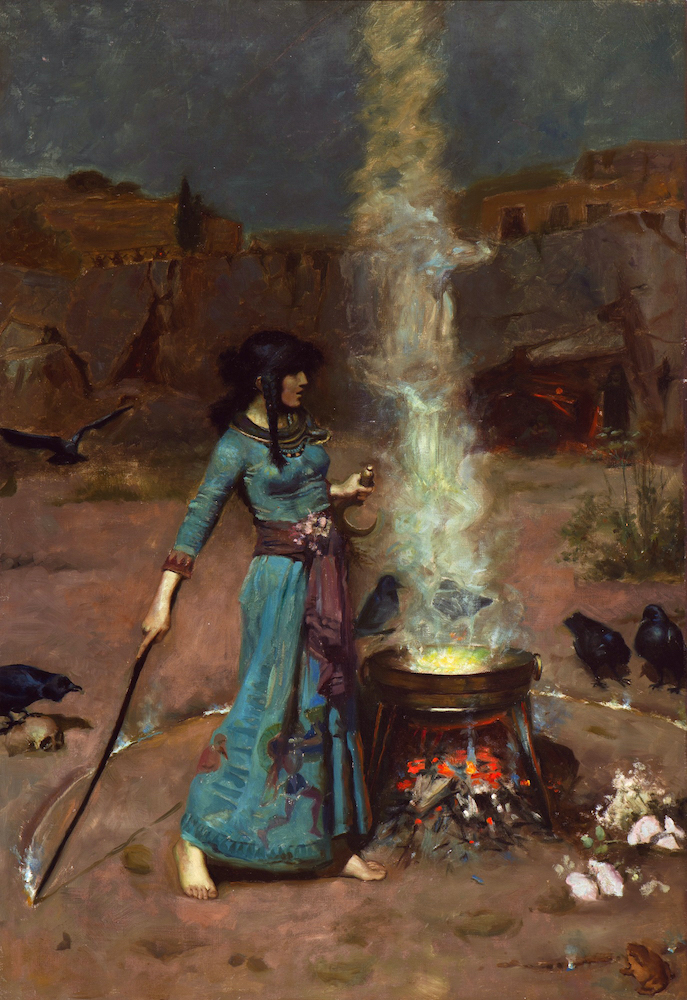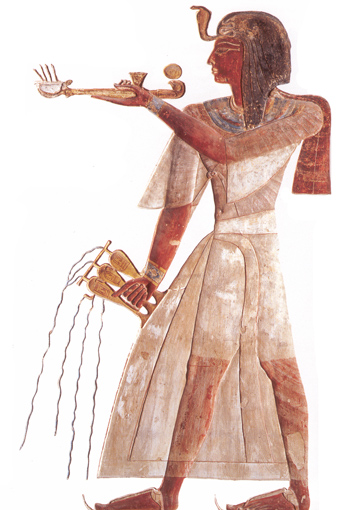I often find it easier to keep up my spiritual practice when I have something “set,” something specific, to do. Like a small ritual that I’ve pretty much got memorized. Is that true for you? If so, then today I’d like to share with you just such a small ritual. This one is an offering rite. It is adapted from the Daily Ritual in the Egyptian temples. (If you have your new copy of Offering to Isis, a version of it is in there. Here’s a version you can use, and of course, adapt, as you choose.)
I’ve called this one the Adma Iset, “Offering to Isis.” Adma is one of the (many) Egyptian words for an offering rite. I preferred the sound of this one compared to some of the others, so I adopted it. Based on Egyptian temple rites, this ritual is adapted for a single person instead of a temple-full of folks.

The Adma Iset
Ritual Tools: A cup or other vessel of pure water; a censer with charcoal and incense; fire starter for incense; an offering (this can be anything you choose: milk, beer, flowers, a poem, a dance); a small reed mat (such as a table place mat); a shallow tray of sand large enough to place one foot in; a bundle of fresh plants for sweeping the sand. These last two are optional, but are adapted from things they actually did in Egyptian temples. You can do this rite at your altar; I will assume you have a sacred image of Isis on your altar.
Ritual Preparation: Prepare your offering as needed; set the small reed mat on the floor before the altar; place the tray with sand and the fresh plants conveniently to the side.
Purification & Consecration
Sit comfortably before your altar, breathing slowly, clearing your mind. When you are ready, rise, approach the altar of Isis, and bow politely.
Ritualist: (Raising your hands in a gesture of adoration) Isis is all things and all things are Isis.
Take up the cup and elevate it.
Ritualist: (To the Purifying Powers) O, You Souls of Night, Water Dwellers, Purifiers, You of the Pure Water from the Sycamore Tree of Isis, I have come for you. By the Blood, by the Power, by the Magic of Isis, establish yourselves within this vessel!
Lower the cup to heart level. Visualize blue light coming into your body from above, let it move through your body into the earth, then bring it back up into your heart, then into the cup as you vibrate.
Ritualist: (Vibrating) ISET MU [EE-set MOO; Egyptian: “Isis of Water”]!
Circle your ritual space, sprinkling water, then sprinkle yourself.
Ritualist: (Speaking while walking) Isis is pure. The temple is pure. The temple is pure. I am pure. I am pure with the Purity of Isis. I am pure with the Purity of the Goddess. (Repeating until you return to the altar; then repeat as needed until you feel the truth of your statement.)
Ritualist: By the Magic of Isis, it is so!

Return cup to altar, take up censer and elevate it.
Ritualist: (To the Consecrating Powers) O, You Souls of Day, Fire Dwellers, Consecrators, You of the Pure Breath from the Mouth of Isis, I have come for you. By the Blood, by the Power, by the Magic of Isis, establish yourselves within this censer!
Lower the censer to heart level. Visualize red light coming into your body from above, let it move through your body into the earth, then bring it back up into your heart, then into the censer as you vibrate.
Ritualist: (Vibrating) ISET ASH [EE-set AHshh; Egyptian: “Isis of Fire”]!
Circle your ritual space, censing it and then yourself.
Ritualist: (Speaking while walking) Isis is consecrated. The temple is consecrated. The temple is consecrated. I am consecrated. I am consecrated with the Fire of Isis. I am consecrated with the Flame of the Goddess. (Repeating until you return to the altar; then repeat as needed until you feel the truth of your statement.)
Ritualist: By the Magic of Isis, it is so!
Entering

Face the altar and make the Gesture of Adoration.
Ritualist: Isis is upon Her Throne. The spirits awaken! They awaken in peace for they know that I have come to make offering unto this Great Goddess.
Put your palms together and extend your arms straight out in front of you. Slowly open your arms as if opening a heavy curtain. This is the gesture of Opening the Shrine. Place the tray of sand before the sacred image and step in it to leave a footprint in the sand.
Ritualist: The sacred doors are opened to me. The light goes forth. It guides me on a fair path to the place where the Great Goddess is. I approach Your shrine, O Isis.
Offering to the Uraeus Goddess
Take up the censer and elevate it.
Ritualist: (Addressing the Uraeus serpent form of Isis) The Sacred Eye is powerful. Lady of Flame, Great One Who is between the horns of the Sunshine Goddess, accept this perfume and let me enter in peace.
Place the censer in your dominant hand, resting on your upturned palm. Bring that hand to your heart. Breathe in and visualize light glowing around the censer. Slowly swing your arm outward toward the image of the Goddess. Visualize the light flowing from the incense smoke to Her sacred image. This is the Gesture of Giving. Return the censer to its place.
Invoking the Goddess

Stand before the sacred image. Place your palms together in front of you as if preparing to applaud. Bring them apart to a comfortable distance, remaining thumbs up. To make the Gesture of Invocation, move the tips of your fingers towards you in a ‘come to me’ gesture. Do this slowly and gently as you speak the invocation below.
Ritualist: Iu en-i. Iu en-i (Eeoou-en-EE; Egyptian: “Come to me”). Come to me, come to me, Beautiful, Great One—Isis of Many Names, Great of Magic, Great Mother, Great Goddess. Come to me, come to me! (Vibrating) ISIS. ISIS. ISIS.
See within your heart the light of the Goddess. Feel it glowing with sun-bright warmth and beauty.
(Speaking to the Goddess) Fair is Your coming to Your temple, Isis. Beautiful is Your appearance in my heart.
Place your hand upon your heart, breathe in, and on the out-breath, move your hand toward the altar and send that light into the sacred image of Isis.
Making Offering

You may continue to stand or be seated at this time.
Ritualist: My body being on Earth, my heart being awake, my magic being in my mouth, O Isis, I make offering unto You.
Take up your offering. With open heart, speak aloud why you have chosen to give that particular offering for the Goddess.
If your offering is physical, use the Gesture of Giving (above) to offer it to Isis. If it is not, visualize a symbol representing it in your palm as if it were physical. Breathe in, visualize light around the offering, then on the out-breath, move your hand toward the altar and see that light transfer to the sacred image of Isis. Then, if your offering is performative, perform the offering (e.g. read the poem, dance the dance).
The Reversion of Offerings (optional section)
Standing, make the Gesture of Adoration toward the sacred image of Isis. Close your eyes and visualize the Goddess tracing an ankh symbol over the offering you have given. It glows with the power of Life, the power of Her Divine Ka. She breathes a blessing into it. She breathes a blessing into you. Breathe Her breath and be blessed.
Ritualist: The offering is reverted. Its blessing comes to me. Its blessing goes out into the world. Its beauty endures forever.
Note: Offerings such as food and drink, once reverted, may be consumed by you and your household. Non-consumable offerings may be kept on Isis’ altar or kept in some other convenient place nearby.
Closing the Temple
Once again, take some time to see the light of what you have given glowing around the sacred image of Isis. Let yourself know that She has accepted your offering. Feel Her blessing upon you in return.
When you are ready, take up the bundle of plants and sweep away the footprint in the sand. Make the Gesture of the Closing of the Shrine (the opposite of Opening the Shrine above).
Ritualist: I have flourished on water. I have grown on incense. I have climbed up on sunbeams. O Isis, give me Your hand for I have made offering unto You.
Be in peace, Isis, be in peace. Amma, Iset (AH-ma, EE-set; Egyptian: “Grant that it be so, Isis”).
The Adma is finished. Exit the ritual space or remain in meditation as desired.

















